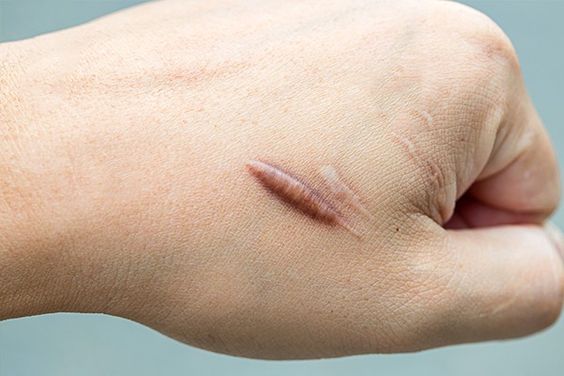During the wound healing process, scar formation is a natural physiological reaction. However, sometimes scars may overgrow, forming the so-called "scar hyperplasia". Scar hyperplasia not only affects the appearance, but may also cause discomfort symptoms such as pain and itching. How to determine whether a wound has scar hyperplasia? Today, let me guide you on how to identify whether a wound is undergoing this change.

How long does it usually take for scarring to appear?
Scar hyperplasia usually begins to appear within 1-3 weeks after the wound heals, which means that you may see scar hyperplasia in about 30 days.
How to determine whether a wound has scar hyperplasia?
1. Look (appearance and color) :
Hypertrophic scars usually look different from normal scars. Hypertrophic scars tend to be red or purple, with a smooth surface but a hard texture. At the same time, the edges of hypertrophic scars are often unclear and may be irregular in shape. If you find that the scars at the wound meet these characteristics, it may be a sign of hypertrophic scars. We also need to look at the color of the scar. Pay special attention to those scars that are red in color. Some scars may even be abnormally bright red even though they are not obviously raised. Some may even have red blood on the surface of the scar. These are all signs that we need to be vigilant about. Next, I will tell you how to judge the degree of scar hypertrophy by the color of the scar. If your scar is blood red, then it means that the scar hypertrophy is in the active stage. Intervention treatment at this time can effectively inhibit the hypertrophy of scars, and the treatment difficulty is relatively low, and the effect will be better. If your scar is pink in color, then it means that the proliferation of scars is slowing down and the scars are beginning to stabilize. At this stage, the effect of conventional medication or compression treatment may be limited. If the scar turns dark red, or even black or purple, it means that the capillaries in the scar are not supplying enough blood, the scar's proliferation has basically stopped, and it has entered the mature stage. The size of the scar will no longer change during the mature stage. If the scar turns white or off-white, it means that the scar's proliferation stage has ended and the scar has entered the regression stage.
2. Touch :
In addition to observing the appearance, we can also judge whether the scar has proliferated by touching it. Hypertrophic scars are usually firm and have a distinct texture compared to the surrounding normal skin. Additionally, hypertrophic scars may be painful or uncomfortable to touch. If you feel significant hardness or pain when touching the scar at the wound site, it may be a sign of scar hyperplasia.
When scars proliferate, how should we deal with them?
After the wound heals, we can follow the doctor's advice and use silicone scar cream or scar patch to prevent or inhibit proliferation. For areas with high tension such as knees and limbs, we can consider wearing elastic sleeves or pressure garments for compression treatment. In addition, laser redness reduction intervention is also an optional treatment modality. If the scar has matured, or the scar has been around for a long time, or the hyperplasia is severe, we can consider treatment methods such as scar acupuncture, surgery, and radiotherapy.

Care tips:
The wound should be clean and dry to avoid infection; avoid over-stimulating the scar area to avoid aggravating symptoms; eat a reasonable diet and maintain balanced nutrition to help promote wound healing and scar fading. We should pay attention to the healing of wounds and promptly detect and deal with signs of scar hyperplasia. Through the diagnosis and treatment of professional doctors, as well as daily care and maintenance, we can effectively improve the problem of scar hyperplasia and maintain the beauty and health of the skin.
For more information on Innomed®Silicone Scar Dressing, refer to the previous articles. If you have customized needs, you are welcome to contact us; we will serve you wholeheartedly.
At Longterm Medical, we transform this data by innovating and developing products that make life easier for those who need loving care.
Editor: kiki Jia

 English
English عربى
عربى Español
Español русский
русский 中文简体
中文简体








